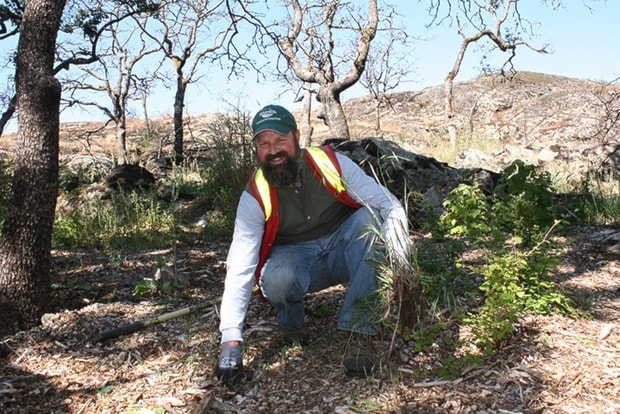The brush fire that raged in Camrose Park last June has led to a natural areas restoration project with a bright future.
At the fire’s height, it threatened dozens of homes. Residents whose yards backed onto the park spent hours using garden hoses to soak their trees, lawns and gardens with hopes of protecting their properties from the advancing threat.
Smoke billowed, and the fire wiped out a tract of Garry oak ecosystem that could date back centuries. The cause of the fire was never determined, said Saanich Fire Department assistant chief Todd Cave.
Because Garry oaks are far more naturally fire resistant than other trees, and due to the quick action of Saanich Fire Department, which sprayed enough water to fill a small lake, not a tree was lost. And now there’s a silver-lining in place, as Saanich Parks and the local Pulling Together volunteer program are nurturing the most fertile section of Camrose Park (which faces Maplewood Road). Before the fire, that same area was overrun with invasive species.
“It became a good opportunity to re-establish a native Garry oak ecosystem there,” said Andrew Giles, manager of parks construction and maintenance.
It’s now an active restoration site, with Saanich crews stopping every two weeks by to manage the growth, said Andrew Burger, natural areas technician with Saanich Parks.
“The fire burned most of the blackberry down to the root balls. It was actually the heavily established invasive species and other underbrush that burned. Not one (mature) tree was lost, but I’m betting at least a few Garry oak seedlings did get burned.”
Burger pointed to branches that are still not producing leaves, though many are.
“You can see where the flames licked the trees, but didn’t burn them,” Burger said. “Garry oaks are deep rooted with a thick bark [that holds water], it’s why the First Nations were able to burn right around them to clear growth and plant camas.”
During the fall and winter, Saanich Parks crews stopped by regularly to monitor the natural regrowth, and with “little effort and to great effect,” were able to remove a few more blackberry root balls, added Burger, who was pulling invasive sprouts next to Maplewood on Monday morning. “Because the blackberry really suppressed everything, we have to let the area grow to see what comes up,” he said. “Some is native, but some is still invasive but was also suppressed.”
Camrose Park is a unique one to Saanich. There are other “rocky outcrop” type parks, but most have at least a minor trail system. Because Camrose has no trail system, it is technically closed to the public. Of course, there are several foot paths and established entries to the park. It is assumed it was careless human activity, perhaps a cigarette butt, that initially started the fire. And now, more than ever, the park is particularly sensitive to visitors.
“There is an added sensitivity now during the restoration,” Burger said. “People will be stepping on bulbs in shallow soil that weren’t there before, and they won’t know because the bulb could take a year or two to sprout.”
Following the fire Pulling Together volunteers took time to root through the burned areas and find camas bulbs. They were sorted and redistributed into the surviving “soil pockets” among the rocky areas, Giles said.
Parks crews then added bark mulch to the land next to Maplewood, which helps suppress weeds and invasive species from seeding.
Snowberry and Nootka rose is coming in where it hasn’t had a chance, and Saanich has also planted nodding onion, camas, chickweed monkey flower and sea blush, all common rocky outcrop species.
“Overall the cost has been under $5,000, it’s a big return on very little money,” Giles said.
